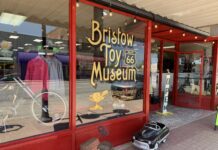In the July installment of this column, I wrote about Red Dirt music’s Mike McClure and the new record label he’d started with friend Chance Sparkman, 598 Recordings (named for the phone prefix Sparkman and McClure share in their hometown of Tecumseh.) With acts including the Damn Quails and McClure himself, 598 surged right out of the gate.
Then, the label scored a real coup, releasing the first new disc by singer-songwriter Tom Skinner in more than a decade.
For those who know Red Dirt music, this is a very big deal. But don’t take my word for it. Ask Garth Brooks, who calls it “a very, very special gift from Tom to all of his fans . . . of which I am one.” Or listen to Steve Ripley, head of the platinum selling-group the Tractors, who says, “Like none other, when Tom Skinner sings … I listen.”
In addition to those two musical heavyweights, Tom Skinner’s new, eponymously titled disc comes with the enthusiastic endorsement of such leading lights of the Red Dirt movement as Cody Canada, Stoney LaRue, Jason Boland and McClure himself, who are all quoted in publicity material for the new CD.
Sure, hyperbole is a part of the entertainment business. But in the case of Skinner, the praise is justified, and then some. Skinner is not only one of the originators of the Red Dirt sound; he’s also a guy who’s done more than his fair share to keep it going since the very beginning. Among other things, his weekly Tom Skinner Science Project shows – basically, Red Dirt revues – have been a part of Tulsa’s entertainment scene for the past dozen years, bringing audiences a musical potpourri that exemplifies the unselfishness and collaborative nature of the Red Dirt scene.
Tom Skinner’s new, eponymously titled disc comes with the enthusiastic endorsement of such leading lights of the Red Dirt movement as Cody Canada, Stoney LaRue, Jason Boland and Mike McClure.
Skinner’s new album does the same thing. A longtime fan might be surprised to see several other songwriters represented on Tom Skinner, especially since Skinner is as well-known for his songwriting as for his performing. But, in true Red Dirt fashion, Skinner wanted to spread things around a little bit.
“Well, to be honest, I write some songs – and I’m glad I do – but I feel like I probably get more credit as a songwriter than I deserve,” he says. “And I have so many good friends who are great songwriters that it’s hard not to do some of their songs. I could do this great song that a guy has, or I could do one of mine that’s not as good.”
Is Skinner just being modest? Probably. But it’s a trait he shares with most of the rest of his Red Dirt comrades, who seem far more interested in expressing themselves through well-crafted lyrics and having fun with one another than in chasing the national spotlight.
It wasn’t always that way for Skinner, though. In the 1980s, he and Brooks were musical partners in a popular Stillwater-based group called Santa Fe. The guys – including Skinner’s brothers Craig and Mike – played a type of music that anticipated Red Dirt: country-influenced, especially in its emphasis on the lyric rather than the groove, blended with rock and folk and other musical elements. In a 2002 interview I did with Brooks for the Tulsa World, he said, “My sound was created in Stillwater…I don’t think we would’ve had this sound anywhere else. And if I hadn’t run into the Skinner brothers, I don’t think you would’ve heard the sound we had.”
In the late ‘80s, Santa Fe took its shot at stardom, heading to Nashville to try and score a record deal. Against overwhelming odds, Brooks came through the struggle to emerge, ultimately, as one of the biggest pop-music stars who ever lived. Skinner, on the other hand, gave up the chase.
“When I came back from Nashville, I was burned out,” he admits. “I moved back to Bristow, where I’m from. I had a family and stuff, and I just went to work.”
He landed a position with the city’s water department, where he’d remain for some five years, putting the notion of stardom behind him. But about a month after he’d begun the day job, he made a life-changing discovery.
“I’d always thought that I wanted to do another one, because I wanted to make a record that I liked,”
“I’d kind of quit playing music,” he says. “But then, one day, I realized it wasn’t the music I was sick of; it was all the stuff that went on around it, trying to keep a band going and all of that. That’s what I was burned out on. So I just went back to the bedroom with a guitar and tried to reconnect with what made me like music in the first place – which was basically the way a guitar sounded, a G-chord ringing.
“I learned that, really, all that other stuff didn’t matter. And that’s when I started developing the “mud hole” theory of life. As you walk down the road, there are mud holes, and you can jump in them if you want to, but you don’t have to. You can step around them, you can jump over them and you can go on. You don’t have to get in them.”
Certainly, the new disc is no mud hole. But it still took a little time before Skinner decided to jump into it. He’d recorded a couple of discs back in the late ‘90s for the independent Binky Records, but he hadn’t been satisfied with either – partly, he thinks, because he produced them himself.
“I’d always thought that I wanted to do another one, because I wanted to make a record that I liked,” he explains. “So that was my long-range goal. But I just got so busy playing all the time that I never quite got around to it.
“Mike (McClure) has been after me to do one for a while,” he adds. “Then, when he got this record label started, he said, ‘Okay, I’m just going to have to make you do it.’ I said, ‘You don’t have to make me. Just tell me when you want me to be there and I’ll be there.’”
The Tom Skinner CD, produced by Joe Hardy (whose credits include Steve Earle, the Georgia Satellites and ZZ Top) and McClure, emerges as a disc that any artist could be proud of. In addition to both vintage and brand-new originals, Skinner covers the likes of fellow Oklahoman Hoyt Axton (“Gypsy Moth”), The Rev. Gary Davis (“Light of This World,” in which Skinner references the late Red Dirt Ranger Benny Craig), and Randy Pease, one of the first songwriters Skinner met in Stillwater following his discharge from the Army in the late ‘70s. The Pease contribution, “I Love This Game,” is told from the viewpoint of a washed-up minor-league pitcher, and it joins Skinner’s liner notes and his new publicity photo in suggesting a baseball motif for the disc.
“Well, I don’t know about that,” says Skinner with a laugh, “but I do know that when you’re playing baseball, you’re a kid again – and music is kind of the same way. When you’re on stage, I figure it ought to be the best two or three hours of your day.”
Tom Skinner is available at online outlets, Tulsa-area stores and at Tulsa’s The Colony on Wednesday nights, when The Tom Skinner Science Project can be seen and heard.






















